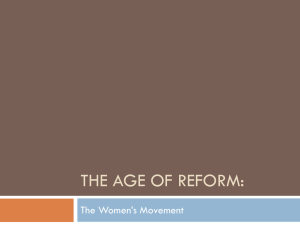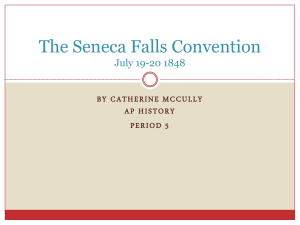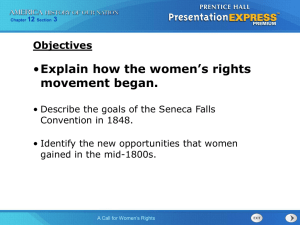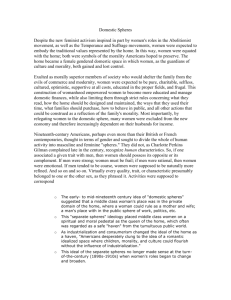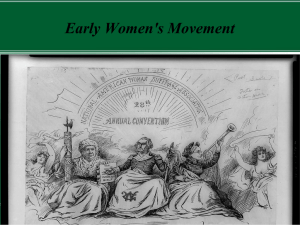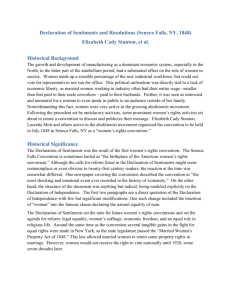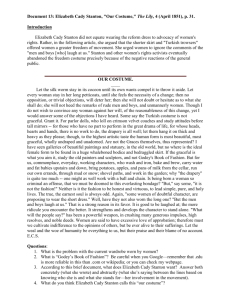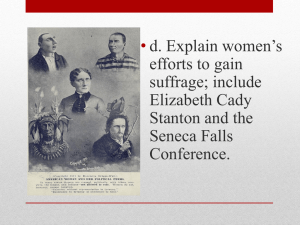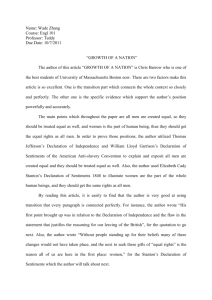TIMELINE OF MAJOR EVENTS INVOLVING WOMEN IN THE 19TH
advertisement
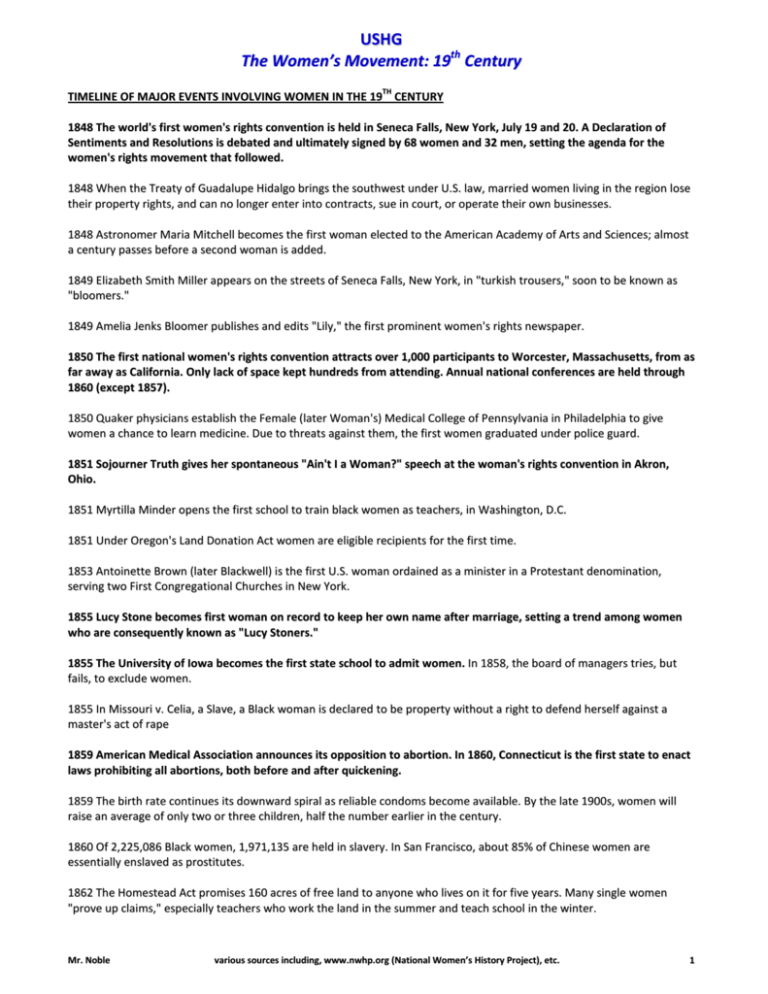
USHG The Women’s Movement: 19th Century TH TIMELINE OF MAJOR EVENTS INVOLVING WOMEN IN THE 19TH CENTURY 1848 The world's first women's rights convention is held in Seneca Falls, New York, July 19 and 20. A Declaration of Sentiments and Resolutions is debated and ultimately signed by 68 women and 32 men, setting the agenda for the women's rights movement that followed. 1848 When the Treaty of Guadalupe Hidalgo brings the southwest under U.S. law, married women living in the region lose their property rights, and can no longer enter into contracts, sue in court, or operate their own businesses. 1848 Astronomer Maria Mitchell becomes the first woman elected to the American Academy of Arts and Sciences; almost a century passes before a second woman is added. 1849 Elizabeth Smith Miller appears on the streets of Seneca Falls, New York, in "turkish trousers," soon to be known as "bloomers." 1849 Amelia Jenks Bloomer publishes and edits "Lily," the first prominent women's rights newspaper. 1850 The first national women's rights convention attracts over 1,000 participants to Worcester, Massachusetts, from as far away as California. Only lack of space kept hundreds from attending. Annual national conferences are held through 1860 (except 1857). 1850 Quaker physicians establish the Female (later Woman's) Medical College of Pennsylvania in Philadelphia to give women a chance to learn medicine. Due to threats against them, the first women graduated under police guard. 1851 Sojourner Truth gives her spontaneous "Ain't I a Woman?" speech at the woman's rights convention in Akron, Ohio. 1851 Myrtilla Minder opens the first school to train black women as teachers, in Washington, D.C. 1851 Under Oregon's Land Donation Act women are eligible recipients for the first time. 1853 Antoinette Brown (later Blackwell) is the first U.S. woman ordained as a minister in a Protestant denomination, serving two First Congregational Churches in New York. 1855 Lucy Stone becomes first woman on record to keep her own name after marriage, setting a trend among women who are consequently known as "Lucy Stoners." 1855 The University of Iowa becomes the first state school to admit women. In 1858, the board of managers tries, but fails, to exclude women. 1855 In Missouri v. Celia, a Slave, a Black woman is declared to be property without a right to defend herself against a master's act of rape 1859 American Medical Association announces its opposition to abortion. In 1860, Connecticut is the first state to enact laws prohibiting all abortions, both before and after quickening. 1859 The birth rate continues its downward spiral as reliable condoms become available. By the late 1900s, women will raise an average of only two or three children, half the number earlier in the century. 1860 Of 2,225,086 Black women, 1,971,135 are held in slavery. In San Francisco, about 85% of Chinese women are essentially enslaved as prostitutes. 1862 The Homestead Act promises 160 acres of free land to anyone who lives on it for five years. Many single women "prove up claims," especially teachers who work the land in the summer and teach school in the winter. Mr. Noble various sources including, www.nwhp.org (National Women’s History Project), etc. 1 USHG The Women’s Movement: 19th Century TIMELINE cont. 1862 Mary Jane Patterson is the first African-American woman to receive a full baccalaureate degree, from Oberlin College. Three European-American women had been graduated in 1841 from Oberlin College: Mary Hosford, Elizabeth Smith Prall, and Caroline Mary Rudd. 1862 Congress passed the Morrill Act, which established land grant colleges in rural areas. Through them, millions of women earn low-cost degrees. 1863 Olympia Brown, first woman to be ordained as a minister by the full authority of her denomination (Northern Universalists). 1865 Hundreds of white women go South to teach at Freedman Schools. 1866 14th Amendment is passed by Congress (ratified by the states in 1868), the first time "citizens" and "voters" are defined as "male" in the Constitution. 1866 The American Equal Rights Association is founded, the first organization in the U.S. to advocate national women's rights. "Never doubt that a small group of thoughtful, committed citizens can change the world. Indeed, it's the only thing that ever has." That was Margaret Mead's conclusion after a lifetime of observing very diverse cultures around the world. Her insight has been borne out time and again throughout the development of this country of ours. Being allowed to live life in an atmosphere of religious freedom, having a voice in the government you support with your taxes, living free of lifelong enslavement by another person. These beliefs about how life should and must be lived were once considered extreme by many. But these beliefs were fervently held by visionaries whose work brought about changed minds and attitudes. Now these beliefs are commonly shared across U.S. society. Another initially outlandish idea that has come to pass: United States citizenship for women. 1998 marked the 150th Anniversary of a movement by women to achieve full civil rights in the U.S. Over the past seven generations, dramatic social and legal changes have been accomplished that are now so accepted that they go unnoticed by people whose lives they have utterly changed. Many people who have lived through the recent decades of this process have come to accept what has transpired. And younger people, for the most part, can hardly believe life was ever otherwise. They take the changes completely in stride, as how life has always been. The staggering changes for women that have come about over those seven generations in family life, in religion, in government, in employment, in education - these changes did not just happen spontaneously. Women themselves made these changes happen, very deliberately. Women have not been the passive recipients of miraculous changes in laws and human nature. Seven generations of women have come together to affect these changes in the most democratic ways: through meetings, petition drives, lobbying, public speaking, and nonviolent resistance. They have worked very deliberately to create a better world, and they have succeeded hugely. Mr. Noble various sources including, www.nwhp.org (National Women’s History Project), etc. 2 USHG The Women’s Movement: 19th Century The Women's Rights Movement is being celebrated across the nation with programs and events taking every form imaginable. Like many amazing stories, the history of the Women's Rights Movement began with a small group of people questioning why human lives were being unfairly constricted. A Tea Launches a Revolution The Women's Rights Movement marks July 13, 1848 as its beginning. On that sweltering summer day in upstate New York, a young housewife and mother, Elizabeth Cady Stanton, was invited to tea with four women friends. When the course of their conversation turned to the situation of women, Stanton poured out her discontent with the limitations placed on her own situation under America's new democracy. But women had not gained freedom even though they'd taken equally tremendous risks through those dangerous years. Surely the new republic would benefit from having its women play more active roles throughout society. Stanton's friends agreed with her, passionately. This was definitely not the first small group of women to have such a conversation, but it was the first to plan and carry out a specific, large-scale program. Within two days of their afternoon tea together, this small group had picked a date for their convention, found a suitable location, and placed a small announcement in the Seneca County Courier. They called "A convention to discuss the social, civil, and religious condition and rights of woman." The gathering would take place at the Wesleyan Chapel in Seneca Falls on July 19 and 20, 184 8. In the history of western civilization, no similar public meeting had ever been called. A "Declaration of Sentiments" is Drafted These were patriotic women, sharing the ideal of improving the new republic. They saw their mission as helping the republic keep its promise of better, more egalitarian lives for its citizens. As the women set about preparing for the event, Elizabeth Cady Stanton used the Declaration of Independence as the framework for writing what she titled a "Declaration of Sentiments." In what proved to be a brilliant move, Stanton connected the nascent campaign for women's rights directly to that powerful American symbol of liberty. The same familiar words framed their arguments: "We hold these truths to be self-evident; that all men and women are created equal; that they are endowed by their Creator with certain inalienable rights; that among these are life, liberty, and the pursuit of happiness." In this Declaration of Sentiments, Stanton carefully enumerated areas of life where women were treated unjustly. Eighteen was precisely the number of grievances America's revolutionary forefathers had listed in their Declaration of Independence from England. Mr. Noble various sources including, www.nwhp.org (National Women’s History Project), etc. 3 USHG The Women’s Movement: 19th Century Stanton's version read, "The history of mankind is a history of repeated injuries and usurptations on the part of man toward woman, having in direct object the establishment of an absolute tyranny over her. To prove this, let facts be submitted to a candid world." Then it went into specifics: Married women were legally dead in the eyes of the law Women were not allowed to vote Women had to submit to laws when they had no voice in their formation Married women had no property rights Husbands had legal power over and responsibility for their wives to the extent that they could imprison or beat them with impunity Divorce and child custody laws favored men, giving no rights to women Women had to pay property taxes although they had no representation in the levying of these taxes Most occupations were closed to women and when women did work they were paid only a fraction of what men earned Women were not allowed to enter professions such as medicine or law Women had no means to gain an education since no college or university would accept women students With only a few exceptions, women were not allowed to participate in the affairs of the church Women were robbed of their self-confidence and self-respect, and were made totally dependent on men Elizabeth Cady Stanton's draft continued: "Now, in view of this entire disenfranchisement of one-half the people of this country, their social and religious degradation, -- in view of the unjust laws above mentioned, and because women do feel themselves aggrieved, oppressed, and fraudulently deprived of their most sacred rights, we insist that they have immediate admission to all the rights and privileges which belong to them as citizens of these United States." The First Women's Rights Convention The convention was convened as planned, and over the two-days of discussion, the Declaration of Sentiments and 12 resolutions received unanimous endorsement, one by one, with a few amendments. The only resolution that did not pass unanimously was the call for women's enfranchisement. That women should be allowed to vote in elections was almost inconceivable to many. Lucretia Mott, Stanton's longtime friend, had been shocked when Stanton had first suggested such an idea. And at the convention, heated debate over the woman's vote filled the air. Even the heartfelt pleas of Elizabeth Cady Stanton, a refined and educated woman of the time, did not move the assembly. Not until Frederick Douglass, the noted Black abolitionist and rich orator, started to speak, did the uproar subside. Woman, like the slave, he argued, had the right to liberty. "Suffrage," he asserted, "is the power to choose rulers and make laws, and the right by which all others are secured." In the end, the resolution won enough votes to carry, but by a bare majority. The Declaration of Sentiments ended on a note of complete realism: "In entering upon the great work before us, we anticipate no small amount of misconception, misrepresentation, and ridicule; but we shall use every instrumentality within our power to effect our object. We shall employ agents, circulate tracts, petition the State and national Legislatures, and endeavor to enlist the pulpit and the press in our behalf. We hope this Convention will be followed by a series of Conventions, embracing every part of the country." Mr. Noble various sources including, www.nwhp.org (National Women’s History Project), etc. 4 USHG The Women’s Movement: 19th Century The Backlash Begins Stanton was certainly on the mark when she anticipated "misconception, misrepresentation, and ridicule." Newspaper editors were so scandalized by the shameless audacity of the Declaration of Sentiments, and particularly of the ninth resolution -- women demanding the vote!-- that they attacked the women with all the vitriol they could muster. The women's rights movement was only one day old and the backlash had already begun. In ridicule, the entire text of the Declaration of Sentiments was often published, with the names of the signers frequently included. Just as ridicule today often has a squelching effect on new ideas, this attack in the press caused many people from the Convention to rethink their positions. Many of the women who had attended the convention were so embarrassed by the publicity that they actually withdrew their signatures from the Declaration. But most stood firm. And something the editors had not anticipated happened: Their negative articles about the women's call for expanded rights were so livid and widespread that they actually had a positive impact far beyond anything the organizers could have hoped for. People in cities and isolated towns alike were now alerted to the issues, and joined this heated discussion of women's rights in great numbers! The Movement Expands The Seneca Falls women had optimistically hoped for "a series of conventions embracing every part of the country." And that's just what did happen. Women's Rights Conventions were held regularly from 1850 until the start of the Civil War. Some drew such large crowds that people actually had to be turned away for lack of sufficient meeting space. The women's rights movement of the late 19th century went on to address the wide range of issues spelled out at the Seneca Falls Convention. Elizabeth Cady Stanton and women like Susan B. Anthony, Lucy Stone, and Sojourner Truth traveled the country lecturing and organizing for the next forty years. Eventually, winning the right to vote emerged as the central issue, since the vote would provide the means to achieve the other reforms. All told, the campaign for woman suffrage met such staunch opposition that it took 72 years for the women and their male supporters to be successful. The story of diligent women's rights activism is a litany of achievements against tremendous odds, of ingenious strategies and outrageous tactics used to outwit opponents and make the most of limited resources. Among these women are several activists whose names and accomplishments should become as familiar to Americans as those of Thomas Jefferson, Abraham Lincoln and Martin Luther King, Jr. Elizabeth Cady Stanton, of course. And Susan B. Anthony. Matilda Joslyn Gage. Lucy Stone. They were pioneer theoreticians of the 19th-century women's rights movement. Esther Morris, the first woman to hold a judicial position, who led the first successful state campaign for woman suffrage, in Wyoming in 1869. Abigail Scott Duniway, the leader of the successful fight in Oregon and Washington in the early 1900s. Mr. Noble various sources including, www.nwhp.org (National Women’s History Project), etc. 5 USHG The Women’s Movement: 19th Century Ida B. Wells-Barnett and Mary Church Terrell, organizers of thousands of African-American women who worked for suffrage for all women. Harriot Stanton Blatch, daughter of Elizabeth Cady Stanton, and Alice Stone Blackwell, Lucy Stone's daughter, who carried on their mothers' legacy through the next generation. Anna Howard Shaw and Carrie Chapman Catt, leaders of the National American Woman Suffrage Association in the early years of the 20th century, who brought the campaign to its final success. Alice Paul, founder and leader of the National Woman's Party, considered the radical wing of the movement. Mr. Noble various sources including, www.nwhp.org (National Women’s History Project), etc. 6
